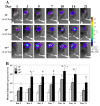The effect of surface demineralization of cortical bone allograft on the properties of recombinant adeno-associated virus coatings
- PMID: 18590929
- PMCID: PMC2570090
- DOI: 10.1016/j.biomaterials.2008.06.007
The effect of surface demineralization of cortical bone allograft on the properties of recombinant adeno-associated virus coatings
Abstract
Freeze-dried recombinant adeno-associated virus (rAAV) coated structural allografts have emerged as an approach to engender necrotic cortical bone with host factors that will persist for weeks following surgery to facilitate revascularization, osteointegration, and remodeling. However, one major limitation is the nonporous cortical surface that prohibits uniform distribution of the rAAV coating prior to freeze-drying. To overcome this we have developed a demineralization method to increase surface absorbance while retaining the structural integrity of the allograft. Demineralized bone wafers (DBW) made from human femoral allograft rings demonstrated a significant 21.1% (73.6+/-3.9% versus 52.5+/-2.6%; p<0.001) increase in percent surface area coating versus mineralized controls. Co-incubation of rAAV-luciferase (rAAV-Luc) coated DBW with a monolayer of C3H10T1/2 cells in culture led to peak luciferase levels that were not significantly different from soluble rAAV-Luc controls (p>0.05), although the peaks occurred at 60h and 12h, respectively. To assess the transduction efficiency of rAAV-Luc coated DBW in vivo, we first performed a dose response with allografts containing 10(7), 10(9) or 10(10) particles that were surgically implanted into the quadriceps of mice, and assayed by in vivo bioluminescence imaging (BLI) on days 1, 3, 5, 7, 10, 14, and 21. The results demonstrated a dose response in which the DBW coated with 10(10) rAAV-Luc particles achieved peak gene expression levels on day 3, which persisted until day 21, and was significantly greater than the 10(7) dose throughout this time period (p<0.01). A direct comparison of mineralized versus DBW coated with 10(10) rAAV-Luc particles failed to demonstrate any significant differences in transduction kinetics or efficiency in vivo. Thus, surface demineralization of human cortical bone allograft increases its absorbance for uniform rAAV coating, without affecting vector transduction efficiency.
Figures




References
-
- Lord CF, Gebhardt MC, Tomford WW, Mankin HJ. Infection in bone allografts. Incidence, nature, and treatment. J Bone Joint Surg Am. 1988;70:369–376. - PubMed
-
- Berrey BH, Jr, Lord CF, Gebhardt MC, Mankin HJ. Fractures of allografts. Frequency, treatment, and end-results. J Bone Joint Surg Am. 1990;72:825–833. - PubMed
-
- Enneking WF, Campanacci DA. Retrieved human allografts : a clinicopathological study. J Bone Joint Surg Am. 2001;83-A:971–986. - PubMed
-
- Hornicek FJ, Gebhardt MC, Tomford WW, Sorger JI, Zavatta M, Menzner JP, et al. Factors affecting nonunion of the allograft-host junction. Clin Orthop Relat Res. 2001;382:87–98. - PubMed
-
- Wheeler DL, Enneking WF. Allograft bone decreases in strength in vivo over time. Clin Orthop Relat Res. 2005;435:36–42. - PubMed
Publication types
MeSH terms
Substances
Grants and funding
- DK 065988/DK/NIDDK NIH HHS/United States
- EY 005951/EY/NEI NIH HHS/United States
- R01 AR051469/AR/NIAMS NIH HHS/United States
- R21 DE017096/DE/NIDCR NIH HHS/United States
- R01 EY005951/EY/NEI NIH HHS/United States
- R01 DE019902/DE/NIDCR NIH HHS/United States
- AR 54041/AR/NIAMS NIH HHS/United States
- R01 AR067859/AR/NIAMS NIH HHS/United States
- AR 46545/AR/NIAMS NIH HHS/United States
- P30 DK065988/DK/NIDDK NIH HHS/United States
- P01 HL051818/HL/NHLBI NIH HHS/United States
- R21 DE026256/DE/NIDCR NIH HHS/United States
- R01 AR046545/AR/NIAMS NIH HHS/United States
- P50 AR054041/AR/NIAMS NIH HHS/United States
- AR 51469/AR/NIAMS NIH HHS/United States
- DE 17096/DE/NIDCR NIH HHS/United States
- HL 51818/HL/NHLBI NIH HHS/United States
LinkOut - more resources
Full Text Sources

